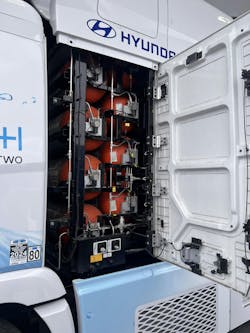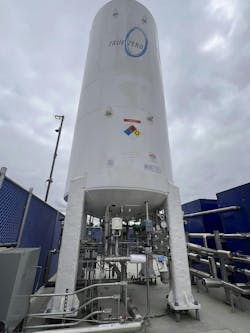Clean hydrogen has the potential to cut trucking’s carbon output. However, filling large H2 tanks for fuel cells and internal combustion engine trucks is complicated. FirstElement Fuel, which will open the nation’s first public hydrogen truck stop this month, has solved this fueling challenge with a cryopump.
“As we started rolling out a network of [light-duty] stations, we quickly learned that technology that was available out there was not commercially viable,” said Dr. Shane Stephens, FirstElement founder and chief development officer. “It couldn't scale, it couldn't meet the needs of the public, and it didn't have the reliability for the business model necessary to make it viable.”
Customers waiting to fill their hydrogen vehicles at FirstElement’s first-generation stations didn’t like the experience, Joel Ewanick, FirstElement’s executive chairman of its board of directors, explained. The fueling method to pump 3 to 4 kg of hydrogen for smaller, consumer vehicles took 30 to 40 minutes. Using that same fueling technology to fuel heavy-duty vehicles, which require about 60 kilograms of hydrogen for a complete fill, would prove excessively inefficient.
Overcoming this obstacle, FirstElement began using a hydrogen fueling method called cryopump. FirstElement has used cryopump technology at its light-duty stations for five years, establishing the company as the “technology leader in bringing hydrogen cryopumps into the commercial setting,” Stephens said.
What is cryopump technology?
Hydrogen refueling is more complex than gasoline and diesel refueling. This is because “hydrogen is stored on-site either in liquid form at minus 253 degrees Celsius [minus 423 degrees Fahrenheit] or as a gas in tanks with various pressure levels,” according to a Bosch Rexroth press release. This means that “hydrogen must be compressed in a controlled manner to between 700 and 900 bar,” about 10,000 to 13,000 psi, to refuel vehicles.
As hydrogen moves, it heats up. When filling a Class 8 vehicle’s large tank, it rapidly expands. To achieve a fast fill, hydrogen must be pre-cooled to prevent it from heating up to the point that it loses its energy, Stephens explained.
The cryopump FirstElement now uses solves this problem because it compresses hydrogen by 700 bar, leading to much quicker refuel times. It also maintains the sub-cooled temperature. In one step, a cryopump converts cold, liquid hydrogen into cold, compressed hydrogen and delivers it into the vehicle.
The cryopump also uses only about one-fifth of the energy that compressors need for an alternative method of hydrogen refueling. Further, the whole system takes up less space. A cryopump can deliver a higher capacity of hydrogen while taking up about 1/30th of the space needed for a compressor, Stephens explained.
Using cryopump technology, “we went from being able to [fill] 40 cars per day to being able to fill about 400 cars per day,” Stephens said. “[Cryopumps] got us to fast fills, simultaneous refueling, and higher volume overall. They also established a platform by which we could scale up to the needs required for heavy-duty trucking.”
The first FirstElement station equipped with cryopump technology came to California in 2019. Since then, FirstElement has deployed 20 light-duty vehicle stations with this technology, bringing FirstElement Fuel’s total station footprint to 41 locations with 92 fueling stations, supporting more than 16,000 fuel cell cars in California, Stephens said.
See also: Feds fueling $8B nationwide hydrogen hub investment






